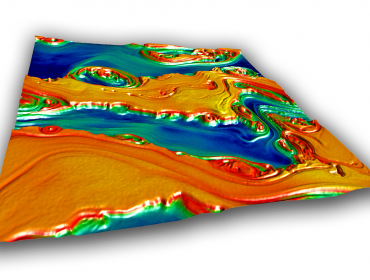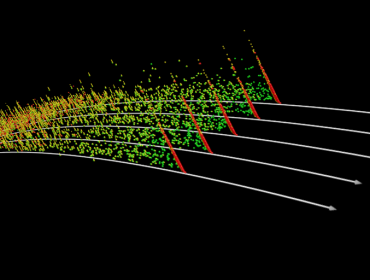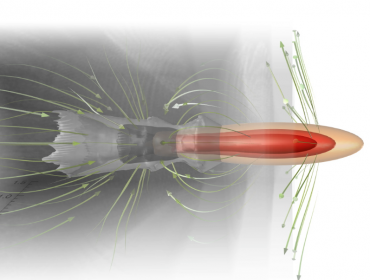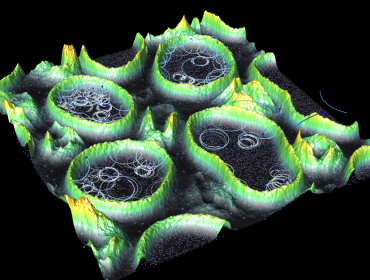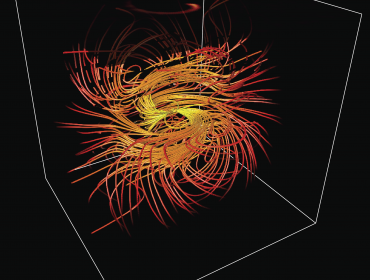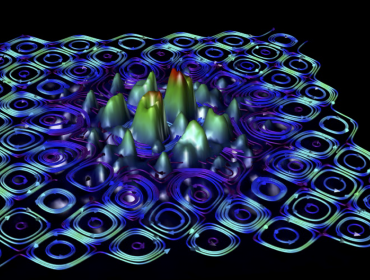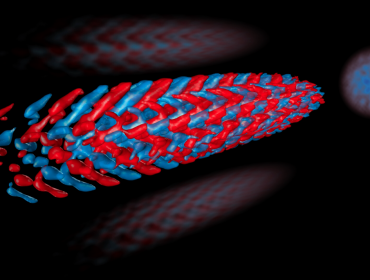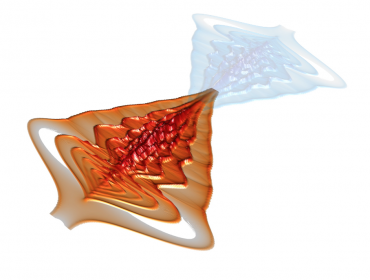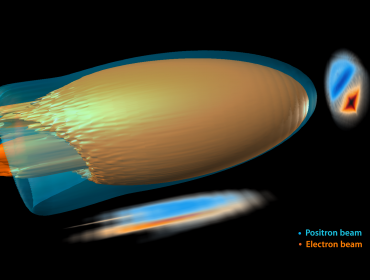-
Magnetic vortex in astrophysics collisionless accretion disk
Read moreThe accretion disks around massive objects, like black holes, are astrophysical scenarios where the plasma is characterised by a state of differential rotation around the central massive object, with the angular velocity decreasing with the radius. In this configuration the plasma is characterised by the MagnetoRotational Instability (MRI), a crucial mechanism for the growth of the magnetic field in the accretion disks and the transport of angular momentum throughout these objects.
In some astrophysical scenarios, like accretion disks around massive black holes at the centre of the galaxies, the plasma becomes collisionless and a kinetic approach to the dynamic of the system is required. Resorting to ab initio 2D PIC simulations, we are able to study the evolution of the kinetic MRI in the radial-vertical plane of a portion of plasma far from the centre of rotation of the accretion disk. The figure shows the space distribution of the toroidal…
January 27, 2017 -
High orbital angular momentum harmonics generation
Read moreHigh harmonic generation (HHG) results from non-linear optical processes by which n photons, each with a given frequency ω, combine into a single photon with frequency nω. Because it can lead to a strong laser frequency upshift, HHG is routinely used in advanced microscopy techniques. In recent HHG experiments, where the incident photon beam contained an initial level of orbital angular momentum (OAM) ℓ, the final photon contained, in addition, an OAM level given by nℓ. In these experiments, which demonstrated the conservation of angular momentum (ℓ) and energy (ω), the OAM harmonics were coupled to the frequency harmonics.
We have recently investigated an unexplored mechanism that opens the possibility to create high OAM harmonics while leaving the laser frequency unchanged, thereby treating the orbital angular momentum as a true independent degree of freedom. Our theoretical calculations and numerical simulations show that the order of the high harmonics obeys…
January 27, 2017 -
Populating pulsar magnetospheres via QED cascades
Read morePulsars are astronomical objects that gather a wealth of extreme physical conditions, making them extraordinary physics laboratories (for fields as diverse as general relativity, quantum mechanics, and plasma astrophysics). They are surrounded by strong dipolar magnetic fields (of the order of 1012 G) and support very active, exotic magnetospheres.
The ultra-intense magnetic field existent in these regions is close to the Schwinger field for vacuum breakdown, and hence the dynamics of charged particles must take into account the self-consistent interaction with these fields, as well as radiation reaction and QED mechanisms such as hard photon emission and their subsequent decay that results in electron-positron pairs. Unravelling the dynamics of astrophysical plasmas in these environments is a critical step towards a complete understanding of a multitude of phenomenology, including the radiation signatures and the spin down of pulsars, the formation and the quasi-steady state of their magnetospheres, and the acceleration of…
January 27, 2017 -
Plasma lenses are not for positrons
Read moreThe idea of exploiting the wakefield of a charged particles beam, formed when traversing a plasma, to focus on axis the beam itself was proposed on 1987 by P. Chen . Linear colliders luminosity benefits incredibly from a reduced spot size of the beams, being inversely proportional to the cross-sectional area.
We simulated a positron beam self-focusing traversing an under-dense plasma lens, which results to be non suitable as the focusing force acting upon the bunch of particles is inhomogeneous.
During the beam (in red) propagation through the plasma lens (in grey), the wake structure is formed due to the transverse motion of the plasma electrons which are drawn on axis, on the contrary of what happens with an electron bunch which repels the plasma electrons away from its path.
Since the plasma electrons are…
January 27, 2017 -
Magnetized Current Filaments: Evolution and single particle dynamics
Read moreWeibel Instability is considered as a promising candidate to explain the origin of strong sub-equipartition magnetic fields in Gamma Ray Bursts (GRBs) and Supernova Remnants (SNRs). These instabilities arise when relativistic outflows from accreting black holes interact with the ambient medium. The radiation from these systems can be attributed to the motion of the constituent particles. Recent observations have reported significant fractions of polarized radiation. Understanding single particle dynamics holds the key to decode radiation and its polarization properties. In most of the cases, the interstellar medium is magnetized. Hence, studying Weibel Instability in magnetized plasmas is important. With the availability of high intensity lasers and e-e+ fireball beams in conventional accelerators, it is possible to study the physics of such astrophysical processes in scaled laboratory experiments.
The movie shows a two dimensional particle in cell (PIC) simulation of a cold relativistic e-p+ plasma flowing perpendicular to the…
January 26, 2016 -
Centrifugally-driven magnetosphere
Read morePulsar magnetospheres are one of the most extreme environments in the universe. In the presence of the ultra intense electric and magnetic fields therein (up to 106 V/cm and 1012 G, respectively!), QED phenomena such hard photon emission (and their subsequent decay into electron-positron pairs) and vacuum nonlinear polarization must be taken into account. The dynamics of the (typically electron-positron) plasmas in these systems and their self-consistent interaction with the fields is, therefore, extremely complex. With ab initio particle-in-cell (PIC) simulations, it is possible to follow this self-consistent collective dynamics, as well as the acceleration and the radiation processes.
The figure above depicts an ab initio PIC simulation of a rotating magnetosphere that captures important collective plasma processes. Electrons and ions are emitted from the surface of a compact, central body that mimics a neutron star, in the regions where the electric field is more intense. This typically occurs in…
January 26, 2016 -
The waves that stand their ground
Read moreThe possibility to create matter from vacuum has been one of the most exciting predictions of quantum electrodynamics. Schwinger in 1951 assumed that for creating spontaneously an electron-positron pair in vacuum, the field has to be strong enough to perform a work of an electron rest mass over a Compton wavelength. This became a definition of the critical field of quantum electrodynamics, below which the probability of creating electron-positron pairs becomes very small. In a field higher than the Schwinger critical field, a single electron or an energetic photon can seed a QED cascade, an avalanche of repeated pair creation that leads to a production of a very large number of particles. Unfortunately, this could not be tested in the lab so far, because the Schwinger critical field was (and still is) beyond reach of state-of-the-art laser technology.
However, there is a way to observe QED cascades with near-future laser…
January 26, 2016 -
Propagation of ultra relativistic fireball beam into plasma
Read moreAb initio PIC simulations of astrophysical plasmas have provided new directions to identify the role of plasma instabilities in the formation of collisionless shock, the particle acceleration processes, and the generation of magnetic field structures compatible with the intense radiation bursts of synchrotron radiation.
It has been known that the interaction of ultra-relativistic beam with plasma drives several plasma instabilities. There are three possible main scenarios depending on the direction of the wave-vector respect to the flow; when the wave-vector is aligned to the flow, the purely two-stream instability driven by the peaked nature of the velocity distribution dominates; when the wave-vector is normal to the flow, the filamentation instability is excited; finally, if the wave-vector is at an arbitrary angle respect to the flow, then it is the oblique instability to play a role. As a consequence of all these instabilities, the beam breaks up into narrow and…
January 26, 2016 -
Disruption effect
Read moreOne of the experiments performed in particle physics consist in colliding two counter-streaming beams, one composed of electrons and the other of positrons. One relativistic beam, composed by charged particles of the same kind, is stable and the coulomb repulsive force is counteracted as 1/2 by the confining magnetic field generated by the charges motion. However when two beams collide the oncoming beam field acts on the bunch as a thin lens focusing the particles on the axis of motion. This focusing produces what is called pinching of the beam: the beam density increases in the focusing spot. After pinching the beam defocuses.
During the interaction, the beam may suffer none, one or multiple pinching according to the strength of the oncoming beam field and to the particles energy. The presence of these pinching spots alters the beam density profile; at the end of the interaction, the density profile results…
January 26, 2016 -
Propagation of quasi-neutral beam into plasma
Read moreUltra-relativistic outflows are of interest not only for astrophysics but also to understand the interaction of relativistic beams with plasmas. The interaction of particle beams (e− and e+) with plasmas has been studied in the context of plasma wakefield accelerators magnetic field generation via current filamentation instability in GRBs scenarios, particle acceleration in collisionless shocks and inertial confinement fusion.
It is known that the interaction of relativistic particle beams with plasmas drives several instabilities such as the current filamentation, two stream and oblique instability. In particular, the first one, known also as electromagnetic instability, is able to drive strong transverse magnetic fields that break up the beam into narrow and high current density filaments and lead to the emission of synchrotron radiation.
Experimentally probing such complex phenomenon is still an open challenge and especially the creation of the astrophysical conditions in laboratory is difficult. However, present laboratory facilities, such as the…
January 22, 2016
extreme plasma physics > Visualizations

